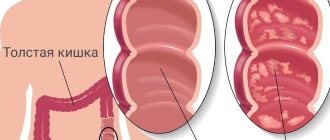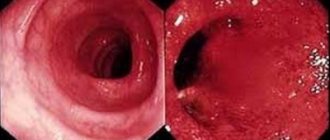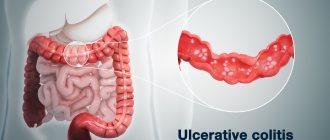Causes
At the moment, there is no exact data on what can cause spastic colitis, that is, it is unclear what triggers cause this disease. This is due to the fact that in most patients the causes of colitis are often different.
The etiology of spastic colitis identifies neurogenic factors as the main causes of spasms in the intestines. These can be prolonged stress and fears, regularly occurring conflict situations, hormonal imbalances, and overwork. Apparently, this is why spastic colitis is more common in women, since fluctuations in hormonal balance associated with the menstrual cycle have a significant impact on the emotional state.
About 30% of patients who sought help acquired spastic colitis after acute intestinal infections. Among them, the main ones were salmonellosis and dysentery. The disease is often preceded by dysbiosis, which develops as a result of prolonged antibacterial therapy.
Symptoms of chronic colitis
More often, total (complete) damage to the entire colon (pancolitis) is observed. The main symptoms are bowel dysfunction (chronic diarrhea or constipation), pain in various parts of the abdomen, sometimes painful urge to defecate, bloating, and rumbling in the abdomen. In most cases, especially with right-sided colitis, diarrhea predominates - defecation occurs up to 10-15 times or more per day, alternating diarrhea and constipation is often observed. When the process worsens, a false urge to defecate appears, accompanied by the passage of gas and individual lumps of feces, covered with strands or flakes of mucus, or mucus streaked with blood, or periodic discharge of mucus in the form of films (pseudomembranous colitis, develops against the background of long-term antibacterial therapy, has severe flow). Pain during colitis is usually cramping or dull, aching, localized mainly in the lateral and lower abdomen, intensifies after eating and before defecation. Flatulence in colitis is explained by impaired digestion of food in the small intestine and changes in the composition of the intestinal microflora. Decreased appetite, nausea, belching, a feeling of bitterness in the mouth, rumbling in the stomach, etc. are often observed. Weakness, general malaise, decreased ability to work, asthenoneurotic syndrome, weight loss, and mild symptoms of polyhypovitaminosis and anemia may be observed. Attention! If the mucous discharge from the rectum is blood-stained and looks like “raspberry jelly,” you should urgently be examined by a doctor to rule out ulcerative or tumor lesions of the intestine.
Diagnosis of chronic colitis
• During a scatological examination (stool analysis), a large amount of mucus and leukocytes, as well as red blood cells (in erosive and ulcerative forms) is determined. Bacteriological studies of stool reveal disturbances in the microflora of the colon. • In a general blood test during exacerbations of colitis, there may be an increase in leukocytes and ESR. Exacerbation of allergic colitis, in addition to a painful attack, is often accompanied by fever and an increase in eosinophils. • Irrigoscopy does not reveal any special changes; functional disorders are detected (acceleration or slowdown of contrast movement through the intestine, changes in the folding of the mucous membrane, spastic contractions or, conversely, atony (relaxation) of the intestinal wall). In severe forms of colitis, changes in the relief of the intestinal mucosa are detected due to inflammatory edema, in some cases, areas of scar-inflammatory narrowing of the intestinal lumen. • Sigmoidoscopy, sigmoidoscopy and colonoscopy most often reveal redness, swelling and bleeding of the intestinal mucosa, less often - erosion, pallor of the mucous membrane in atrophic colitis. • The diagnosis is confirmed by histological examination (biopsy) - examination of a piece of the mucous membrane under a microscope.
Segmental colitis (damage to individual areas of the colon). Chronic typhlitis (damage to the right parts of the colon, in particular, its section called the “cecum”) most often accompanies chronic enteritis and appendicitis, often of alimentary origin. Or the cecum is involved in the process with chronic right-sided adnexitis (inflammation of the right ovary). It occurs with persistent pain in the right iliac region, radiating to the groin and lower back; bloating and rumbling in the right half of the abdomen, in most cases with copious semi-liquid stools 3-5 times a day (“cow feces”). In the area of the cecum and ascending colon there is pain, sometimes they are spastically contracted, sometimes relaxed, and when they are palpated, a strong rumbling is noted.
Isolated transversitis (damage to the transverse portion of the colon) occurs relatively rarely and in many cases is combined with intestinal prolapse. Often caused by difficulty in passing the contents (due to significant prolapse of the transverse colon, the formation of adhesions, abnormal development of the colon and other reasons). It manifests itself as a dull pain in the epigastric, periumbilical regions and left hypochondrium, often intensifying after eating, bloating, rumbling, a feeling of fullness in the abdomen, which is relieved after defecation, and stool disturbances. Proctitis and proctosigmoiditis (isolated damage to the rectum and sigmoid, that is, the left parts of the colon) are the most common forms of chronic colitis. In their origin, a special role is played by bacterial dysentery, chronic constipation, systematic irritation of the rectal mucosa due to abuse of laxatives and therapeutic enemas, suppositories. Manifested by pain in the left iliac region and in the anus, painful urge to defecate, bloating, rumbling of the abdomen; pain may persist for some time after defecation and may occur during a cleansing enema. The stool is often light, sometimes like “sheep feces”, containing a lot of visible mucus, and often blood and pus. On palpation, tenderness of the sigmoid colon, its spastic contraction or rumbling (with diarrhea) is noted.
The course of chronic colitis in some cases is long-term, asymptomatic, in others it is gradually progressive with alternating periods of exacerbations and remissions, and the development of atrophic changes in the intestinal wall. This depends on the hereditary and constitutional characteristics of the body, the nature of nutrition, concomitant pathology (especially the digestive organs), the duration of the disease and its severity. With timely treatment, the prognosis is favorable.
Symptoms
- A disorder of colon motility, accompanied by painful spasms, vaguely localized in the abdomen. Spastic pain often occurs in the morning and after eating.
- This colitis is manifested by a sequential alternation of spastic constipation and diarrhea. Patients report bloating, flatulence (high levels of gases in the intestines), and pain in the colon. Constipation is replaced by diarrhea with liquid or pasty stools.
- In severe cases of the disease, mucus or blood appears in the stool.
A diagnostic examination reveals other symptoms of spastic colitis: hyperemia of the walls of the colon, swelling. Palpation of the abdomen allows you to identify spastic constrictions, which are large painful areas.
Ulcerative colitis is a chronic inflammation of the large intestine. A typical symptom is diarrhea mixed with blood and mucus. In addition, pain appears, often in the epigastric region on the left. In most cases, ulcerative colitis occurs in the form of attacks (exacerbations): during the absence of symptoms, the patient can lead a normal daily life. During an exacerbation, on the contrary, hospitalization may be necessary. Here you can read information about how you can help yourself with ulcerative colitis, how nutrition affects the disease and how inflammation of the large intestine actually occurs.
Spread of ulcerative colitis
Ulcerative colitis always begins in the rectum. From there it can always spread to a greater or lesser extent into the colon.
However, in many patients the inflammation is limited to the rectal area. In this case, doctors talk about proctitis. If the inflammation additionally spreads to the left side of the colon, left-sided colitis occurs. In some patients, the inflammation spreads even further into the large intestine. If the entire large intestine (along with the rectum) is eventually affected, then it is referred to as pancolitis.
As colitis spreads, the severity of symptoms also increases.
Ulcerative colitis: different types of disease course
In more than 80 percent of patients, ulcerative colitis occurs in the form of periodic exacerbations: phases of more or less pronounced symptoms (exacerbations) are replaced by phases without inflammation and complaints. In this case, doctors talk about a chronically relapsing course.
In approximately ten percent of patients, the disease has a chronically constant course. In this form, symptoms do not go away completely after an exacerbation.
In some cases, ulcerative colitis has a fulminant course: the disease begins completely unexpectedly and is accompanied by severe, bloody diarrhea, severe abdominal pain and high fever. Patients quickly lose fluid (dehydration) and symptoms of shock develop. Approximately three to ten patients die with a similar course of the disease.
Ulcerative colitis : treatment
Since the causes of the development of ulcerative colitis are still precisely unknown, causal treatment of the disease is still impossible. However, much can be done to relieve symptoms and extend the symptom-free period between flare-ups. For this purpose, doctors have various medications at their disposal. If complications occur, it may be necessary to use additional medications (for example, antibiotics for an additional bacterial infection).
Surgery is considered as a treatment alternative in cases of severe or complicated ulcerative colitis. In addition, patients themselves can contribute to overcoming the disease and alleviating symptoms. In the following sections you can read more about individual treatment regimens for ulcerative colitis.
Ulcerative colitis : medications
For ulcerative colitis, medications have the best effect directly at the site of inflammation in the intestines, for example, when used in the form of suppositories or an enema. Thanks to this targeted local use of medications, side effects are less likely to develop in comparison with those medications that are taken systemically (for example, in the form of tablets).
The following medications are used in the treatment of ulcerative colitis:
- 5-ASA (5-aminosalicylic acid) : has an anti-inflammatory effect and is used in the form of a precursor, in most cases as the drug Mesalazine. Possible dosage forms are, for example, suppositories, enemas, foam (for insertion through the anus) and tablets.
- Corticoids ("Cortisone") : also have an anti-inflammatory effect (for example, Prednisolone). In milder cases, they are used topically (for example, in the form of suppositories or enema), for more severe symptoms - in the form of tablets.
- Immunosuppressive drugs : active substances that suppress the activity of the immune system (for example, Azathioprine, Methotrexate, Cyclosporine A, Tacrolimus). This may have a positive effect on the course of the disease. These medications are used for severe or complicated ulcerative colitis (for example, if Cortisone is ineffective or is not tolerated by the patient).
- Antibodies to TNF : active substances that inhibit the inflammatory neurotransmitter TNF (for example, Adalimumab, Golimumab, Infliximab). Their use is considered in severe cases of ulcerative colitis if Cortisone is ineffective or is not tolerated by the patient. TNF inhibitors belong to the so-called biological products (biotechnologically manufactured medications that specifically affect certain processes in the body).
Which medications will be used to treat ulcerative colitis in a particular case depends on many factors. Along with the severity of symptoms, the intensity and extent of inflammation in the intestines also play a major role. In addition, the doctor takes into account when planning treatment how well the patient has responded to medications against ulcerative colitis so far, and how high the risk of developing bowel cancer is.
It is equally important to distinguish between exacerbation therapy (treatment of the actual attack) and maintenance therapy (aimed at prolonging the symptom-free intervals between exacerbations; also called maintenance of remission).
Treatment of exacerbations
In case of an acute attack of ulcerative colitis, treatment is intensified gradually, depending on the severity of the disease.
For mild/moderately severe ulcerative colitis, 5-ASA (more precisely Mesalazine) is usually used. For inflammation of only the rectum (proctitis), it is generally sufficient to take one Mesalazine suppository daily (or Mesalazine in the form of a foam or enema). If this is not enough, patients additionally receive oral Mesalazine (tablets, granules) or topical Cortisone (eg, Budesonide rectal foam).
If the inflammation also extends to the colon, Mesalazine is used both locally (in the form of foam or enema) and systemically (in the form of tablets). The dosage depends on the degree of inflammation in the intestines. If the effect of Mesalazine is insufficient or is not tolerated by the patient, the doctor prescribes Cortisone tablets.
A severe form of ulcerative colitis is immediately treated with the use of Cortisone (namely, as an inpatient in a hospital). The medication is used in tablet form or administered through a vein (in the form of infusion/injection). If the effect of Cortisone is insufficient, the patient receives immunosuppressive drugs or antibodies to TNF.
Note: severe ulcerative colitis is said to occur when several criteria are met. These criteria include, for example, six or more severe bloody diarrhea per day, fever, rapid heart rate (tachycardia), and anemia.
Maintenance therapy
Once the exacerbation of the disease has passed, patients should take 5-ASA (preferably Mesalazine) daily for at least two years. This may help prevent a relapse and reduce the risk of developing bowel cancer. Depending on the extent of inflammation, local (foam, suppositories) or systemic use (tablets) may be appropriate. Sometimes it is also necessary to take Mesalazine both locally and systemically.
The Gastroenterology Clinic of the City Clinical Hospital of Solingen specializes in the treatment of ulcerative colitis. If you require consultation and treatment, please contact the staff of our international department, write to us or leave a request for a call back.
Email: [email protected] Tel.: +49 212 5476913 Viber | WhatsApp: +49 173-2034066 | +49 177-5404270 For your convenience, please save the phone number in your phone book and call or write to us for free on WhatsApp, Viber or Telegram. Applications made on weekends or holidays will be processed on the first business day. In urgent cases, request processing is carried out on weekends and holidays.
Diagnostics
To obtain data about the lower parts of the digestive tract, fibrocolonoscopy or retromanoscopy is prescribed. These studies make it possible to detect foci of inflammation on the mucous membrane, determine intestinal tone, and its evacuation force. Foci of inflammation and other changes in the mucosa are a good reason for determining colitis. Among other studies, the state of the intestinal microflora is analyzed. In order to exclude other diseases of the digestive tract, the doctor may prescribe a blood test, stool test, ultrasound, or coprogram.
Treatment
Diet. The main goal of the diet is to limit the consumption of spicy, fatty, salty and other foods that have an irritating effect on the intestines. In addition, you need to include the following foods in your diet: fruits, whole grain bread, beans, vegetables. It is recommended to eat fractional meals 5-6 times a day in small portions. This makes it possible to reduce the intensity of diarrhea, the level of gas formation, and stabilize the patient’s condition.
Drug treatment. Initially, treatment of spastic colitis begins with the prescription of non-steroidal anti-inflammatory drugs (NSAIDs) and antibacterial drugs. Well-known remedies are recommended: analgin, ibuprofen, baralgin, spasmalgon, ketorol. However, it must be remembered that their long-term use can provoke a worsening of the disease and ulceration of the gastrointestinal mucosa. Broad-spectrum antibiotics are also used: ceftriaxone, cefazolin, oxamp. In addition to anti-inflammatory drugs, the doctor prescribes enveloping drugs that help reduce the intensity of the inflammatory process.
To make an appointment at the ABC-Medicine clinic for the treatment of spastic colitis, call +7 (495) 223-38-83.






